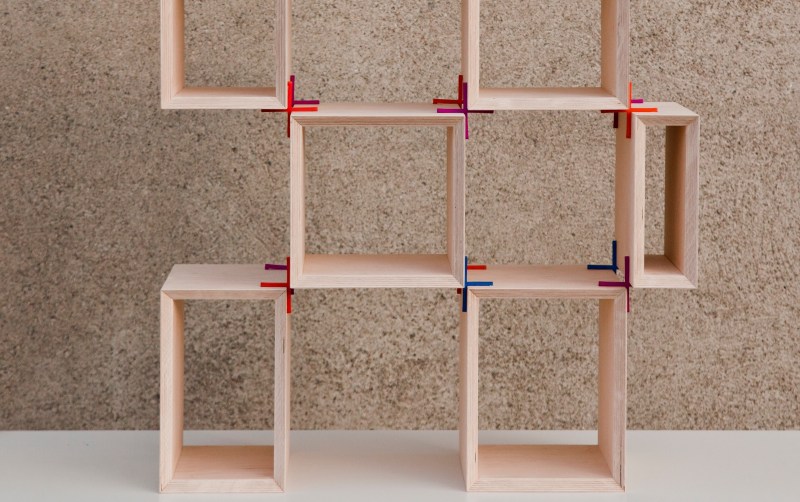Sometimes, you really need a custom shelf. Whether you have a weird-shaped space, weird-shaped stuff, or just want something different, making your own shelving can make your place more like home. The Plus Shelf by [shurly] aims to make building your own shelves a little easier with a 3D printed bracket.
These connectors aren’t just sitting flush against the wood of the shelf. Each end of the + sign actually sits in a 3/8″ drilled recess, giving a more secure fit. The pieces were printed on an Objet and then dyed in various bright shades to really make the shelving pop. The cubbies were assembled with biscuits after cutting down a sheet of plywood to the appropriate sizes. The 45˚ angles around the edges of the cubbies make the whole shelf system that much nicer.
The final shelf has a little wobble, but that’s probably because dying the shelf connectors made them “bendy.” Because of the instability with the friction fit, the shelf connectors were super glued into the shelf boxes. [shurly] hopes that a metal version of the connectors might be able to eliminate these problems in the future.
This shelving system not your cup of tea? Maybe you’d prefer this Vintage Adjustable Shelving Method or this MP3 Player Shelf.
















I mean, if the dying process is what cause the structural problems, the solution seems to be to just use the desired color for the 3D printed material to start.
Didn’t you read?
The shelving ‘pops’…apart. As soon as any weight is put on it.
3d printing this kind of part is just dumb. Strictly for the fashion over function types. The shelves can only hold empty space, to make their artsy fartsy junk stand out more. Hope the art is cheap and durable.
Didn’t you read?
“My next goal for this project is to modify the design to have metal connectors that provide greater structural integrity to the assembly, but I’m pretty happy with how this prototype turned out.”
A witch!
He reads! (I skim)
Burn him.
Even out of metal, it’s a terrible design. Needs shear wall.
Old old joke:
Buildings designed by architects might fall down, but buildings designed by engineers should be torn down.
This shelf is type 1.
A shear wall should not be required for something on a scale of this project. This project’s boxes are made with 3/4 inch plywood and have biscuits and glue in all the joints. The boxes look quite rigid on their own. The prototype 3D printed connectors are just there to facilitate stacking and as the author said, metal ones would be even better. It’s a clever idea.
While we’re quoting things:
“A common mistake that people make when trying to design something completely foolproof is to underestimate the ingenuity of complete fools.” – Douglas Adams
Mark: I bet it would fold right over under the weight of an air cooled VW motor, much less something heavy.
Only good for knickknacks.
Aside: I wish my house had a basement. To much mechanical stuff stored in living space.
Also: 3/4 plywood? Use chip board and close the back. Stronger and much cheaper.
What are the monthly payments on a sheet of 3/4 plywood? Hope he got a good interest rate.
I don’t think it’s the dying process causing the issue, it’s a bad choice of material.
Vero, the material used, is designed for low load functionality testing. Seems pretty fundamental for that type of application.
Unfortunately, I’m doubtful of the design of this system. The connectors aren’t strong enough. Even if the problem of arms “popping” out of sockets is fixed, the design applies the full supported weight into shearing off the thin connector arms. There’s no cross bracing so the entire structure will parallelogram-collapse very easily like a cardboard box with both ends open.
Looks nice, though.
I mean, it’s a neat idea, but it can’t possibly be strong enough to hold much at all, especially on the end cubbies. Even in metal, it desperately needs some sort of cross-bracing or linear straps to allow the brackets to support each other. I suppose you could glue and tack a sheet of thin plyboard or cardboard to the back of the shelves, but that’s going to change the aesthetic to Ikea Bargain Bin.
“The secondary goal was to test whether minimal 3d-printed joints had the structural integrity to hold the weight of solid plywood.”
That sounds utterly ludicrous. Aren’t shelves meant to hold their own weight plus the items placed upon them? Is that why there are no books, pot plants, trinkets on them in the photos? Were they tested with weights? These cross pieces look “as flimsy as” and with no backing panel they would readily twist out of square.
The builder goes on to mention they are for a cubby, but what do kids do but climb on things. I wouldn’t let a small child anywhere near it.
I think this is the mechanical version of ” does it compile? Ship it!”.
Doesn’t link, just compiles. Ship it.
I second any of the comments above that suggest this project is somewhat naff.
Far better than shelves that dont work – recently printed some picture hooks that clip onto bricks to avoid damaging a wall. Couple of iterations, bit fiddly as little to grip but work great. Not for very heavy pictures, but the ones i have aren’t heavy… Should i do a write up – no. It’s not interesting enough for here.
I see why we didn’t get a shot of the brackets:
https://content.instructables.com/ORIG/FM3/X2LO/IDCXG0DO/FM3X2LOIDCXG0DO.jpg
I give it less than a year before plastic deformation makes those little brackets snap. 3D printing structural things intended to hold weight for any period of time is a really dumb idea.